Shan Huang
Speculative Decoding for Verilog: Speed and Quality, All in One
Mar 18, 2025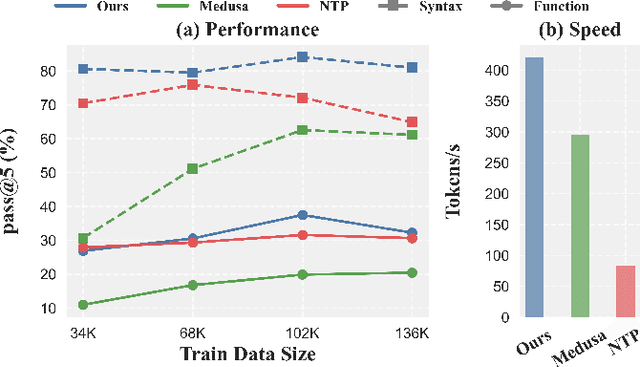
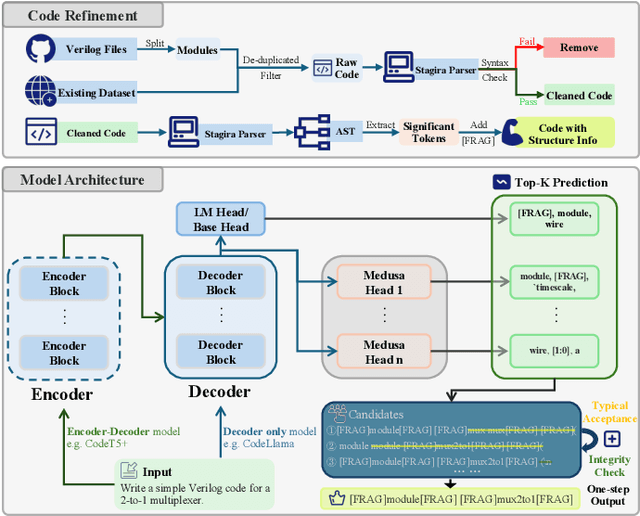
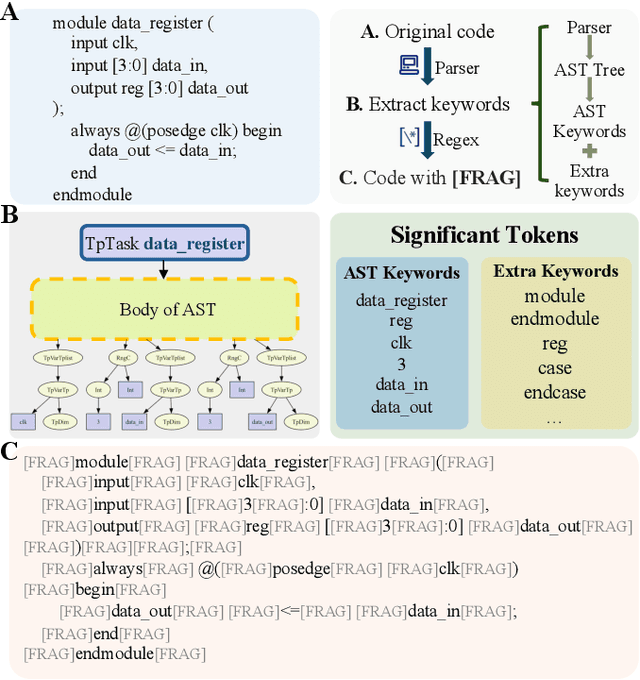
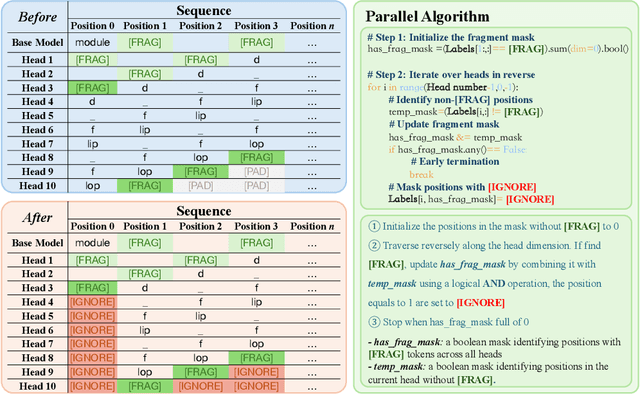
Abstract:The rapid advancement of large language models (LLMs) has revolutionized code generation tasks across various programming languages. However, the unique characteristics of programming languages, particularly those like Verilog with specific syntax and lower representation in training datasets, pose significant challenges for conventional tokenization and decoding approaches. In this paper, we introduce a novel application of speculative decoding for Verilog code generation, showing that it can improve both inference speed and output quality, effectively achieving speed and quality all in one. Unlike standard LLM tokenization schemes, which often fragment meaningful code structures, our approach aligns decoding stops with syntactically significant tokens, making it easier for models to learn the token distribution. This refinement addresses inherent tokenization issues and enhances the model's ability to capture Verilog's logical constructs more effectively. Our experimental results show that our method achieves up to a 5.05x speedup in Verilog code generation and increases pass@10 functional accuracy on RTLLM by up to 17.19% compared to conventional training strategies. These findings highlight speculative decoding as a promising approach to bridge the quality gap in code generation for specialized programming languages.
Enhancing High-Quality Code Generation in Large Language Models with Comparative Prefix-Tuning
Mar 12, 2025Abstract:Large Language Models (LLMs) have been widely adopted in commercial code completion engines, significantly enhancing coding efficiency and productivity. However, LLMs may generate code with quality issues that violate coding standards and best practices, such as poor code style and maintainability, even when the code is functionally correct. This necessitates additional effort from developers to improve the code, potentially negating the efficiency gains provided by LLMs. To address this problem, we propose a novel comparative prefix-tuning method for controllable high-quality code generation. Our method introduces a single, property-specific prefix that is prepended to the activations of the LLM, serving as a lightweight alternative to fine-tuning. Unlike existing methods that require training multiple prefixes, our approach trains only one prefix and leverages pairs of high-quality and low-quality code samples, introducing a sequence-level ranking loss to guide the model's training. This comparative approach enables the model to better understand the differences between high-quality and low-quality code, focusing on aspects that impact code quality. Additionally, we design a data construction pipeline to collect and annotate pairs of high-quality and low-quality code, facilitating effective training. Extensive experiments on the Code Llama 7B model demonstrate that our method improves code quality by over 100% in certain task categories, while maintaining functional correctness. We also conduct ablation studies and generalization experiments, confirming the effectiveness of our method's components and its strong generalization capability.
Large Language Model Inference Acceleration: A Comprehensive Hardware Perspective
Oct 06, 2024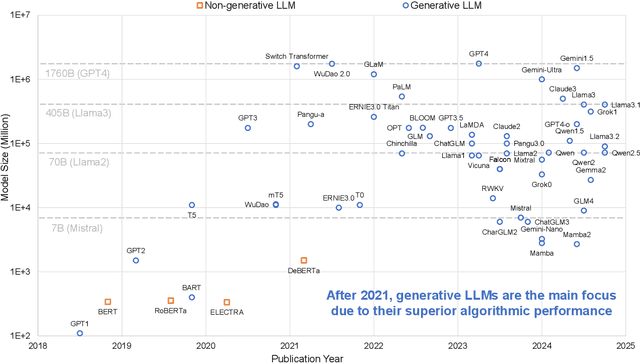

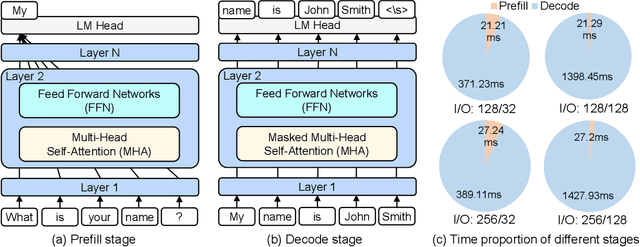
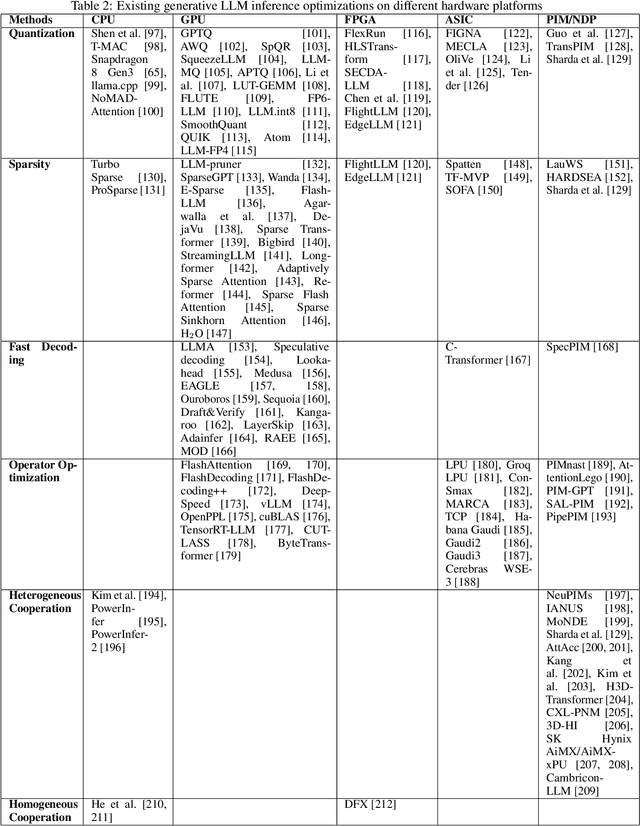
Abstract:Large Language Models (LLMs) have demonstrated remarkable capabilities across various fields, from natural language understanding to text generation. Compared to non-generative LLMs like BERT and DeBERTa, generative LLMs like GPT series and Llama series are currently the main focus due to their superior algorithmic performance. The advancements in generative LLMs are closely intertwined with the development of hardware capabilities. Various hardware platforms exhibit distinct hardware characteristics, which can help improve LLM inference performance. Therefore, this paper comprehensively surveys efficient generative LLM inference on different hardware platforms. First, we provide an overview of the algorithm architecture of mainstream generative LLMs and delve into the inference process. Then, we summarize different optimization methods for different platforms such as CPU, GPU, FPGA, ASIC, and PIM/NDP, and provide inference results for generative LLMs. Furthermore, we perform a qualitative and quantitative comparison of inference performance with batch sizes 1 and 8 on different hardware platforms by considering hardware power consumption, absolute inference speed (tokens/s), and energy efficiency (tokens/J). We compare the performance of the same optimization methods across different hardware platforms, the performance across different hardware platforms, and the performance of different methods on the same hardware platform. This provides a systematic and comprehensive summary of existing inference acceleration work by integrating software optimization methods and hardware platforms, which can point to the future trends and potential developments of generative LLMs and hardware technology for edge-side scenarios.
MARCA: Mamba Accelerator with ReConfigurable Architecture
Sep 16, 2024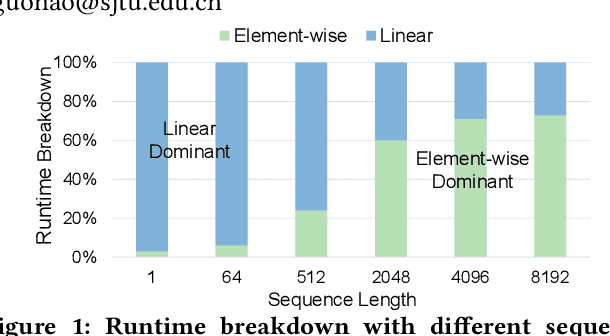


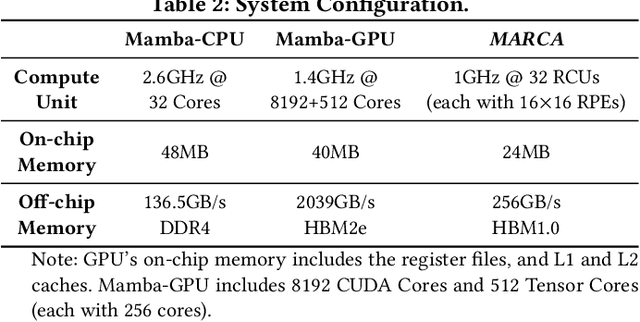
Abstract:We propose a Mamba accelerator with reconfigurable architecture, MARCA.We propose three novel approaches in this paper. (1) Reduction alternative PE array architecture for both linear and element-wise operations. For linear operations, the reduction tree connected to PE arrays is enabled and executes the reduction operation. For element-wise operations, the reduction tree is disabled and the output bypasses. (2) Reusable nonlinear function unit based on the reconfigurable PE. We decompose the exponential function into element-wise operations and a shift operation by a fast biased exponential algorithm, and the activation function (SiLU) into a range detection and element-wise operations by a piecewise approximation algorithm. Thus, the reconfigurable PEs are reused to execute nonlinear functions with negligible accuracy loss.(3) Intra-operation and inter-operation buffer management strategy. We propose intra-operation buffer management strategy to maximize input data sharing for linear operations within operations, and inter-operation strategy for element-wise operations between operations. We conduct extensive experiments on Mamba model families with different sizes.MARCA achieves up to 463.22$\times$/11.66$\times$ speedup and up to 9761.42$\times$/242.52$\times$ energy efficiency compared to Intel Xeon 8358P CPU and NVIDIA Tesla A100 GPU implementations, respectively.
Enabling Fast 2-bit LLM on GPUs: Memory Alignment, Sparse Outlier, and Asynchronous Dequantization
Nov 28, 2023Abstract:Large language models (LLMs) have demonstrated impressive abilities in various domains while the inference cost is expensive. The state-of-the-art methods use 2-bit quantization for mainstream LLMs. However, challenges still exist: (1) Nonnegligible accuracy loss for 2-bit quantization. Weights are quantized by groups, while the ranges of weights are large in some groups, resulting in large quantization errors and nonnegligible accuracy loss (e.g. >3% for Llama2-7b with 2-bit quantization in GPTQ and Greenbit). (2) Limited accuracy improvement by adding 4-bit weights. Increasing 10% extra average bit more 4-bit weights only leads to <0.5% accuracy improvement on a quantized Llama2-7b. (3) Time-consuming dequantization operations on GPUs. The dequantization operations lead to >50% execution time, hindering the potential of reducing LLM inference cost. To tackle these challenges, we propose the following techniques: (1) We only quantize a small fraction of groups with the larger range using 4-bit with memory alignment consideration on GPUs. (2) We point out that the distribution of the sparse outliers with larger weights is different in 2-bit and 4-bit groups, and only a small fraction of outliers require 16-bit quantization. Such design leads to >0.5% accuracy improvement with <3% average increased bit for Llama2-7b. (3) We design the asynchronous dequantization on GPUs, leading to up to 3.92X speedup. We conduct extensive experiments on different model families and model sizes. We achieve 2.85-bit for each weight and the end-to-end speedup for Llama2-7b is 1.74X over the original model, and we reduce both runtime cost and hardware cost by up to 2.70X and 2.81X with less GPU requirements.
TransMRSR: Transformer-based Self-Distilled Generative Prior for Brain MRI Super-Resolution
Jun 11, 2023Abstract:Magnetic resonance images (MRI) acquired with low through-plane resolution compromise time and cost. The poor resolution in one orientation is insufficient to meet the requirement of high resolution for early diagnosis of brain disease and morphometric study. The common Single image super-resolution (SISR) solutions face two main challenges: (1) local detailed and global anatomical structural information combination; and (2) large-scale restoration when applied for reconstructing thick-slice MRI into high-resolution (HR) iso-tropic data. To address these problems, we propose a novel two-stage network for brain MRI SR named TransMRSR based on the convolutional blocks to extract local information and transformer blocks to capture long-range dependencies. TransMRSR consists of three modules: the shallow local feature extraction, the deep non-local feature capture, and the HR image reconstruction. We perform a generative task to encapsulate diverse priors into a generative network (GAN), which is the decoder sub-module of the deep non-local feature capture part, in the first stage. The pre-trained GAN is used for the second stage of SR task. We further eliminate the potential latent space shift caused by the two-stage training strategy through the self-distilled truncation trick. The extensive experiments show that our method achieves superior performance to other SSIR methods on both public and private datasets. Code is released at https://github.com/goddesshs/TransMRSR.git .
A Novel Interpretable and Generalizable Re-synchronization Model for Cued Speech based on a Multi-Cuer Corpus
Jun 05, 2023Abstract:Cued Speech (CS) is a multi-modal visual coding system combining lip reading with several hand cues at the phonetic level to make the spoken language visible to the hearing impaired. Previous studies solved asynchronous problems between lip and hand movements by a cuer\footnote{The people who perform Cued Speech are called the cuer.}-dependent piecewise linear model for English and French CS. In this work, we innovatively propose three statistical measure on the lip stream to build an interpretable and generalizable model for predicting hand preceding time (HPT), which achieves cuer-independent by a proper normalization. Particularly, we build the first Mandarin CS corpus comprising annotated videos from five speakers including three normal and two hearing impaired individuals. Consequently, we show that the hand preceding phenomenon exists in Mandarin CS production with significant differences between normal and hearing impaired people. Extensive experiments demonstrate that our model outperforms the baseline and the previous state-of-the-art methods.
Federated Learning for Metaverse: A Survey
Mar 23, 2023Abstract:The metaverse, which is at the stage of innovation and exploration, faces the dilemma of data collection and the problem of private data leakage in the process of development. This can seriously hinder the widespread deployment of the metaverse. Fortunately, federated learning (FL) is a solution to the above problems. FL is a distributed machine learning paradigm with privacy-preserving features designed for a large number of edge devices. Federated learning for metaverse (FL4M) will be a powerful tool. Because FL allows edge devices to participate in training tasks locally using their own data, computational power, and model-building capabilities. Applying FL to the metaverse not only protects the data privacy of participants but also reduces the need for high computing power and high memory on servers. Until now, there have been many studies about FL and the metaverse, respectively. In this paper, we review some of the early advances of FL4M, which will be a research direction with unlimited development potential. We first introduce the concepts of metaverse and FL, respectively. Besides, we discuss the convergence of key metaverse technologies and FL in detail, such as big data, communication technology, the Internet of Things, edge computing, blockchain, and extended reality. Finally, we discuss some key challenges and promising directions of FL4M in detail. In summary, we hope that our up-to-date brief survey can help people better understand FL4M and build a fair, open, and secure metaverse.
TencentPretrain: A Scalable and Flexible Toolkit for Pre-training Models of Different Modalities
Dec 13, 2022
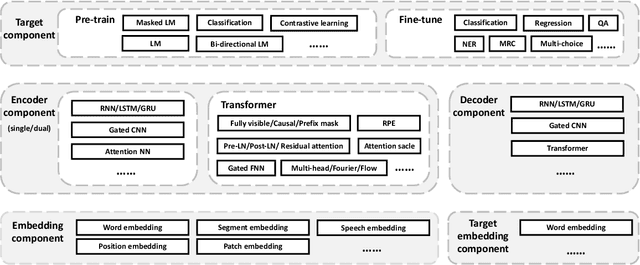
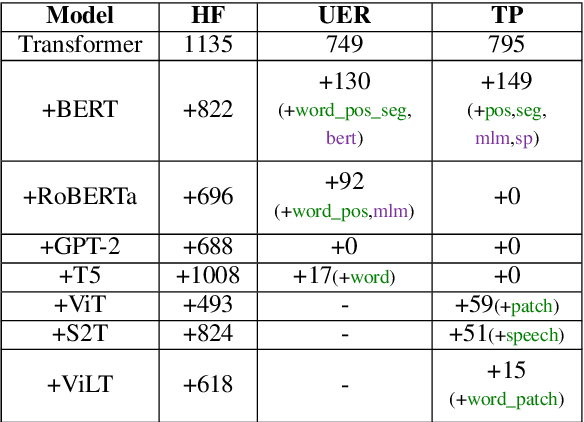

Abstract:Recently, the success of pre-training in text domain has been fully extended to vision, audio, and cross-modal scenarios. The proposed pre-training models of different modalities are showing a rising trend of homogeneity in their model structures, which brings the opportunity to implement different pre-training models within a uniform framework. In this paper, we present TencentPretrain, a toolkit supporting pre-training models of different modalities. The core feature of TencentPretrain is the modular design. The toolkit uniformly divides pre-training models into 5 components: embedding, encoder, target embedding, decoder, and target. As almost all of common modules are provided in each component, users can choose the desired modules from different components to build a complete pre-training model. The modular design enables users to efficiently reproduce existing pre-training models or build brand-new one. We test the toolkit on text, vision, and audio benchmarks and show that it can match the performance of the original implementations.
Contrastive Credibility Propagation for Reliable Semi-Supervised Learning
Nov 17, 2022Abstract:Inferencing unlabeled data from labeled data is an error-prone process. Conventional neural network training is highly sensitive to supervision errors. These two realities make semi-supervised learning (SSL) troublesome. Often, SSL approaches fail to outperform their fully supervised baseline. Proposed is a novel framework for deep SSL, specifically pseudo-labeling, called contrastive credibility propagation (CCP). Through an iterative process of generating and refining soft pseudo-labels, CCP unifies a novel contrastive approach to generating pseudo-labels and a powerful technique to overcome instance-based label noise. The result is a semi-supervised classification framework explicitly designed to overcome inevitable pseudo-label errors in an attempt to reliably boost performance over a supervised baseline. Our empirical evaluation across five benchmark classification datasets suggests one must choose between reliability or effectiveness with prior approaches while CCP delivers both. We also demonstrate an unsupervised signal to subsample pseudo-labels to eliminate errors between iterations of CCP and after its conclusion.
 Add to Chrome
Add to Chrome Add to Firefox
Add to Firefox Add to Edge
Add to Edge